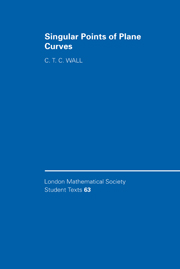Book contents
- Frontmatter
- Contents
- Preface
- 1 Preliminaries
- 2 Puiseux' Theorem
- 3 Resolutions
- 4 Contact of two branches
- 5 Topology of the singularity link
- 6 The Milnor fibration
- 7 Projective curves and their duals
- 8 Combinatorics on a resolution tree
- 9 Decomposition of the link complement and the Milnor fibre
- 10 The monodromy and the Seifert form
- 11 Ideals and clusters
- References
- Index
5 - Topology of the singularity link
Published online by Cambridge University Press: 04 December 2009
- Frontmatter
- Contents
- Preface
- 1 Preliminaries
- 2 Puiseux' Theorem
- 3 Resolutions
- 4 Contact of two branches
- 5 Topology of the singularity link
- 6 The Milnor fibration
- 7 Projective curves and their duals
- 8 Combinatorics on a resolution tree
- 9 Decomposition of the link complement and the Milnor fibre
- 10 The monodromy and the Seifert form
- 11 Ideals and clusters
- References
- Index
Summary
Up to this point we have concentrated on the algebraic side of the description of plane curve singularities. It is even more fascinating to try and visualise them. After a preliminary section on vector fields, in which we recall some standard results from analysis which will give us our main tool for constructing homeomorphisms, we go on to a detailed geometrical description of the local behaviour of a curve at a singular point, which gives in particular a picture of the topology of the link.
We go on to calculate the numerical invariants needed to specify the particular knot or link. Using some basic results about the Alexander polynomial of a knot leads to our main conclusion, that the topology determines the numerical invariants defined earlier.
Vector fields
In this section we develop our main technique for constructing diffeo-morphisms. A first idea is to start with a diffeomorphism somewhere and deform it in a 1-parameter family. We thus define a smooth isotopy from X to Y to be a smooth embedding F : X × I → Y × I of the form F(x, t) = (ft(x), t), so that each ft is a smooth embedding of X into Y ; we also say that the embeddings f0 and f1 are isotopic. The fundamental case is when Y = X and we start at the identity map f0(x) = x.
The second idea is to differentiate F with respect to the ‘time’ variable t. For each P ∈ X, ft(P) describes a smooth curve in X, which thus has a tangent vector at each point.
- Type
- Chapter
- Information
- Singular Points of Plane Curves , pp. 103 - 130Publisher: Cambridge University PressPrint publication year: 2004



